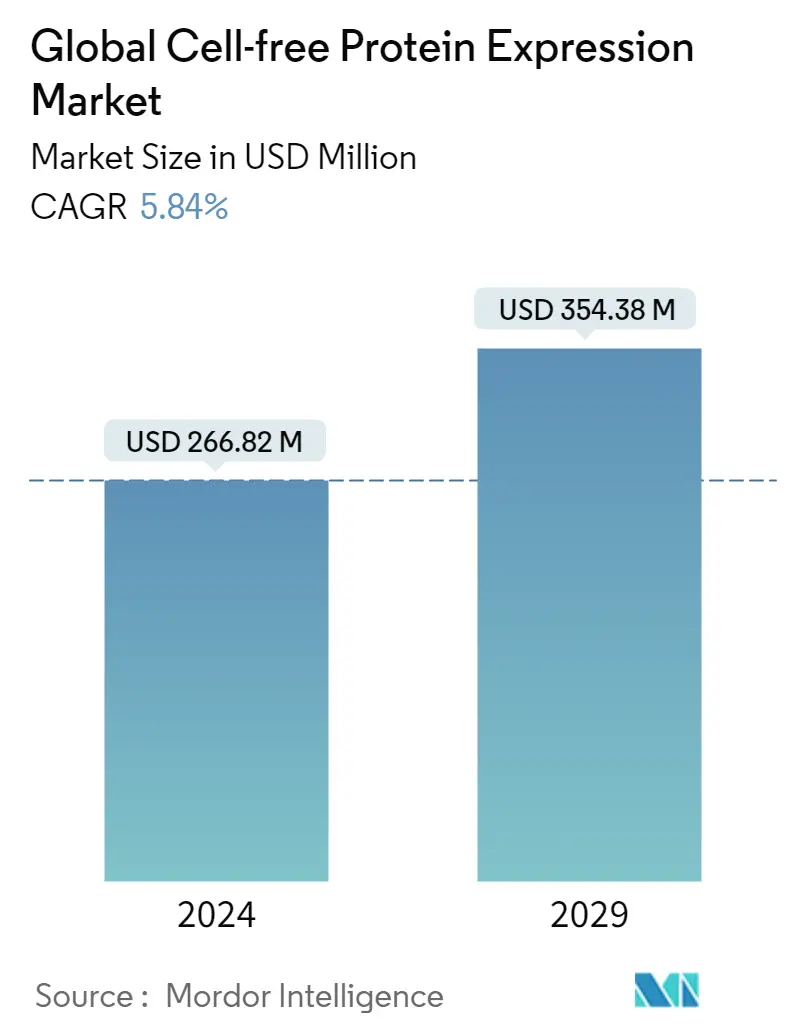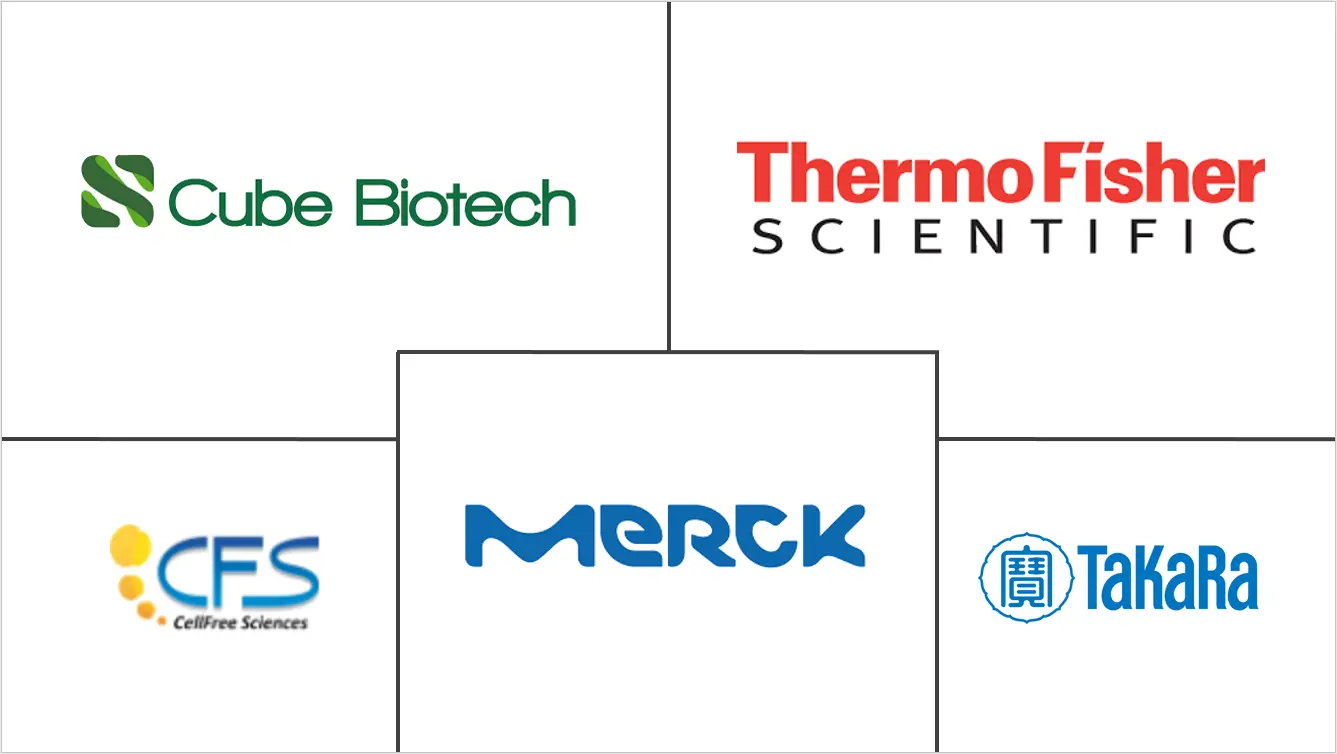Market Size of Global Cell-free Protein Expression Industry

| Study Period | 2019 - 2029 |
| Market Size (2024) | USD 266.82 Million |
| Market Size (2029) | USD 354.38 Million |
| CAGR (2024 - 2029) | 5.84 % |
| Fastest Growing Market | Asia-Pacific |
| Largest Market | North America |
| Market Concentration | High |
Major Players
*Disclaimer: Major Players sorted in no particular order |
Cell-free Protein Expression Market Analysis
The Global Cell-free Protein Expression Market size is estimated at USD 266.82 million in 2024, and is expected to reach USD 354.38 million by 2029, growing at a CAGR of 5.84% during the forecast period (2024-2029).
The market has a slightly positive impact due to the pandemic. Moreover, according to the article, "Harnessing Proteomics Could Improve Therapeutic Approaches to COVID-19," published in November 2020, the development of therapeutic and preventive strategies requires an accurate understanding of proteins' role in the SARS-CoV-2 infection process and progression of COVID-19.
Furthermore, according to the article, "Scientists Develop a High-Throughput, Cell-Free Screening Platform for Anti-SARS-CoV-2 Antibody Discovery," published in November 2021, therapeutic monoclonal antibodies developed against the spike protein of SARS-CoV-2 have become a promising intervention to treat severely ill Coronavirus Disease 2019 (COVID-19) patients. However, the isolation, evaluation, and identification of the best antibody candidate require a series of time-consuming and labor-intensive experiments, including cloning, transfection, cell-based protein expression, protein purification, and critical assessment.
The significant factors for the growth of the Cell-Free Protein Expression Market include the increasing R&D in proteomics and genomics, high prevalence of cancer and infectious diseases, and shorter expression time and structural modification. Cell-free protein expression employs cell lysates to produce the desired recombinant proteins, utilizing Cell Free Protein Synthesis methods. The primary advantage of this technique is the aversion of workflow hurdles of maintaining cell culture or living cells. Cell lysates are produced by the breakdown and use of cellular components of eukaryotic or bacterial cells. Several Cell-Free Protein Expression Systems are currently commercially available, based on E. coli, rabbit reticulocytes, wheat germs, human cell lines, and insect cells.
According to the article, 'Exploring the Potential of Cell-Free Protein Synthesis for Extending the Abilities of Biological Systems,' published in October 2019, Cell-Free Protein Synthesis (CFPS) has the potential to overcome loopholes in the current in vivo production systems and is a promising tool in both primary and applied scientific research. It facilitates a simplified organization of desired experiments with various reaction conditions, making CFPS a powerful tool in biological research. It has been used to expand genetic code, assembly of viruses, and metabolic engineering to produce toxic and complex proteins. Subsequently, CFPS systems have emerged as a powerful technology for the high-throughput Cell Free Protein Production of membrane proteins, enzymes, and therapeutics.
An in vitro protein expression system has significant advantages over living cell-based protein expression, including a shorter duration of the process, isotopic labeling of proteins, incorporation of non-natural amino acids, and optimization of protein complexes. In addition, the ability to enable high-throughput production, the recent trend of more research in personalized medicine, and the growing need for biological therapies to manage cancer is a significant driver for the growth of the In Vitro Protein Expression Market among pharmaceutical and biotechnology firms.
Cell-free Protein Expression Industry Segmentation
As per the scope of this report, cell-free protein expression or in vitro protein synthesis is a process that involves the production of the recombinant proteins in cell lysate solution, without using cell culture or living cells. Cell-free protein expression can be carried out using different cell lysates, such as those of E. coli, rabbit reticulocytes, wheat germs, human cells, and insect cells. The cell-free protein expression market are segmented By Products, Accessories and Consumables , Lysate Systems (E. Coli Lysate, Wheat Germ Extract Lysate, Rabbit Reticulocyte Lysate, Insect Cell Lysate, Human Cell Lysate and Other Lysate Systems), By Application (Enzyme Engineering, High Throughput Production, Protein Labeling, Protein-Protein Interaction and Other Applications) and Geography (North America, Europe, Asia-Pacific, Middle East & Africa, and South America). The report offers the value (in USD million) for the above segments.
| By Products | ||||||||
| Accessories and Consumables | ||||||||
|
| By Application | |
| Enzyme Engineering | |
| High Throughput Production | |
| Protein Labeling | |
| Protein-Protein Interaction | |
| Other Applications |
| Geography | ||||||||
| ||||||||
| ||||||||
| ||||||||
| ||||||||
|
Global Cell-free Protein Expression Market Size Summary
The cell-free protein expression market is poised for growth, driven by advancements in proteomics and genomics, alongside the increasing prevalence of cancer and infectious diseases. This market leverages cell lysates to produce recombinant proteins, offering advantages such as bypassing the complexities of maintaining live cell cultures. The technology is gaining traction due to its ability to facilitate high-throughput production and its application in personalized medicine and biological therapies. Various systems, including those based on E. coli, rabbit reticulocytes, and human cell lines, are commercially available, with E. coli lysates being particularly popular due to their high protein yield and adaptability. Despite some limitations in post-translational modifications, ongoing advancements are expected to sustain the growth of E. coli-based systems.
North America, particularly the United States, dominates the cell-free protein expression market, supported by a robust R&D infrastructure and favorable government policies. The region's market expansion is fueled by the rising incidence of chronic diseases like cancer and the growing demand for targeted therapies. The market is moderately consolidated, with key players such as Thermo Fisher Scientific Inc. and Merck KGaA actively expanding their portfolios through strategic acquisitions. These developments underscore the market's potential, as companies continue to enhance their offerings to meet the increasing demand for efficient and innovative protein expression solutions.
Global Cell-free Protein Expression Market Size - Table of Contents
-
1. MARKET DYNAMICS
-
1.1 Market Overview
-
1.2 Market Drivers
-
1.2.1 Increasing R&D in the Fields of Proteomics and Genomics
-
1.2.2 Growing Burden of Cancer and Infectious Diseases
-
1.2.3 Shorter Expression Time and Structural Modification
-
-
1.3 Market Restraints
-
1.3.1 High Cost of Protein Expression Systems
-
1.3.2 Lack of Effective Systems for Post-translational Modifications
-
-
1.4 Porter's Five Forces Analysis
-
1.4.1 Threat of New Entrants
-
1.4.2 Bargaining Power of Buyers/Consumers
-
1.4.3 Bargaining Power of Suppliers
-
1.4.4 Threat of Substitute Products
-
1.4.5 Intensity of Competitive Rivalry
-
-
-
2. MARKET SEGMENTATION
-
2.1 By Products
-
2.1.1 Accessories and Consumables
-
2.1.2 Lysate Systems
-
2.1.2.1 E. Coli Lysate
-
2.1.2.2 Wheat Germ Extract Lysate
-
2.1.2.3 Rabbit Reticulocyte Lysate
-
2.1.2.4 Insect Cell Lysate
-
2.1.2.5 Human Cell Lysate
-
2.1.2.6 Other Lysate Systems
-
-
-
2.2 By Application
-
2.2.1 Enzyme Engineering
-
2.2.2 High Throughput Production
-
2.2.3 Protein Labeling
-
2.2.4 Protein-Protein Interaction
-
2.2.5 Other Applications
-
-
2.3 Geography
-
2.3.1 North America
-
2.3.1.1 United States
-
2.3.1.2 Canada
-
2.3.1.3 Mexico
-
-
2.3.2 Europe
-
2.3.2.1 Germany
-
2.3.2.2 United Kingdom
-
2.3.2.3 France
-
2.3.2.4 Italy
-
2.3.2.5 Spain
-
2.3.2.6 Rest of Europe
-
-
2.3.3 Asia-Pacific
-
2.3.3.1 China
-
2.3.3.2 Japan
-
2.3.3.3 India
-
2.3.3.4 Australia
-
2.3.3.5 South Korea
-
2.3.3.6 Rest of Asia-Pacific
-
-
2.3.4 Middle-East and Africa
-
2.3.4.1 GCC
-
2.3.4.2 South Africa
-
2.3.4.3 Rest of Middle-East and Africa
-
-
2.3.5 South America
-
2.3.5.1 Brazil
-
2.3.5.2 Argentina
-
2.3.5.3 Rest of South America
-
-
-
Global Cell-free Protein Expression Market Size FAQs
How big is the Global Cell-free Protein Expression Market?
The Global Cell-free Protein Expression Market size is expected to reach USD 266.82 million in 2024 and grow at a CAGR of 5.84% to reach USD 354.38 million by 2029.
What is the current Global Cell-free Protein Expression Market size?
In 2024, the Global Cell-free Protein Expression Market size is expected to reach USD 266.82 million.

